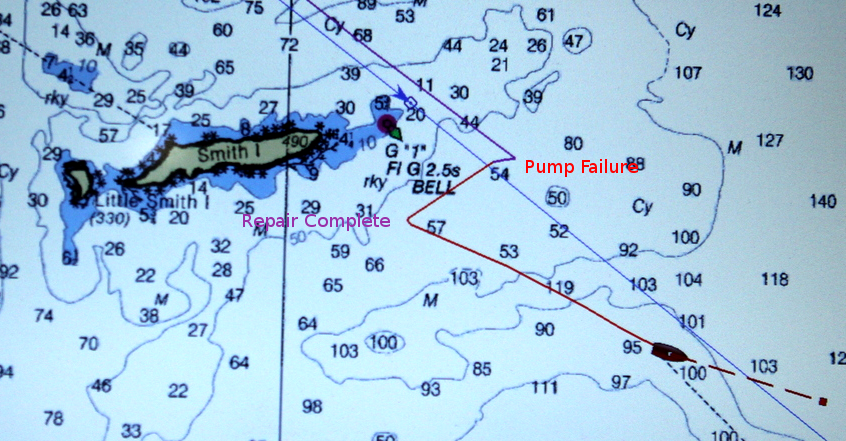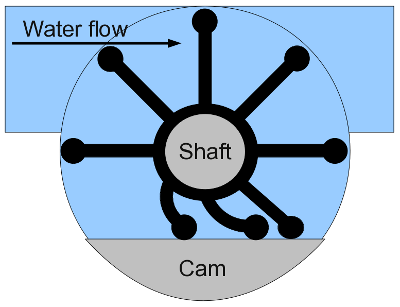

 Share This Page
Share This Page| Home | | Sailing | | Alaska 2014 | |  |  |  Share This Page Share This Page |

Copyright © 2014, P. Lutus. All rights reserved. Message Page
| Prior years: |
Alaska 2002 |
Alaska 2003 |
Alaska 2004 |
Alaska 2005 |
Alaska 2006 Alaska 2007 | Alaska 2008 | Alaska 2009 | Alaska 2010 | Alaska 2011 Alaska 2012 | Alaska 2013 |
(double-click any word to see its definition)

Figure 1: Vessel track during pump repair
Some of my readers will already know this, but not all boating involves sitting around in a calm anchorage lifting Mai-Tais to the sunset. Every once in a while something very serious happens, and it might not be in a place where you just call Vessel Assist and wait 15 minutes to be rescued.
On July 11th I was in Prince William Sound (PWS), Alaska, anchored in a nice place called Cabin Bay where I had made some pleasant hikes over a few days, then had waited out a rather severe storm and, given the changing weather, decided to move the boat to Southeast Alaska.
The forecast called for 30 knot winds that day, but the long-term trend anticipated a spell of nice weather and I wanted to get into position to make my long open-ocean crossing from PWS to the area around Juneau. I decided I would cross from Cabin Bay on Naked Island to Port Etches, near the entrance to PWS.
As I got underway, the winds were as forecast, 30 knots, short choppy seas, but I didn't expect the crossing to be very long so I decided it was worth it. Because of my heading and the wave direction, my Nordic Tug began rolling pretty severely, so I tied things down.
Not to get ahead of myself in this narrative, but impeller pumps must not be allowed to run dry for more than a few seconds — they quickly overheat and self-destruct. As the boat rolled in the waves, the primary raw water pickup on the port side of the bottom may have momentarily risen out of the water from time to time, sucking air instead of water — this is my explanation for what happened next.
I had just gotten things properly tied down and stable when the engine sound suddenly changed. Normally an engine like mine expels a mixture of exhaust and cooling water. The cooling water tends to muffle the engine sound, which produces a rather quiet ride. But all of a sudden my boat sounded like a "dry stack" boat, one that expels its exhaust unmuffled into the atmosphere.
I had barely begun to think about what that might mean when I had my next fun surprise — the engine overheat alarm went off. On a boat like mine, you cannot allow the engine to run overheated, it will self-destruct, so I reluctantly shut down the engine. Now I'm adrift with a dead engine at the position marked "Pump Failure" in Figure 1.
Now consider the situation. I'm in the middle of PWS with a disabled boat (see Figure 1), being blown toward Smith island on a strong wind. My options aren't very good — I can't drop an anchor, water too deep. I can call for rescue, but (apart from having to abandon my boat) a helicopter rescue might take longer to arrive than the time required to drift onto Smith Island's rocks. I could launch my liferaft but I'm safer drifting with my boat to Smith Island and taking my chances in the rocks and breakers.
All the above choices involve certain loss of my boat and possible loss of my life. But there's one more option — I can fix my boat with the tools and spare parts I have on board. A repair won't be easy — as soon as I shut down the engine, the boat turned side-on to the waves and began rolling more severely than it had before. But as I see it, it's my only choice.
Here's what happened next — and remember, the boat is rolling through about 60 degrees every few seconds in the steep seas:
- First, I have to decide what the problem is. If the engine overheat was caused by blockage of the raw water intake port, I might as well wait until I hit the rocks at Smith Island, because diving on my boat under the rough conditions would be suicide.
- I check the raw water intake filter, no blockage.
- I restart the engine for a few seconds just to watch for water coming out of the exhaust — no water.
- I decide the raw water pump impeller is the problem, which means this will be a much more difficult repair, because the impeller is big, hard to manage, and located in a very difficult place.
- I start hunting for my spare impeller. Now I confess, on my boat there are many storage places for spare parts, and all of them are labeled miscellaneous.
- After maybe 15 minutes of struggling around my rolling boat, I locate an impeller, but it turns out to be the impeller for the old engine pump that I replaced five years ago. But I know there's a spare impeller for the new pump, somewhere.
Figure 2: The original engine pump impeller- After another 15 minutes of crawling around, I locate the right impeller.
- I start putting together the tools required to install the impeller, fully aware that installing a big impeller like this is difficult even when sitting on dry land in a boatyard.
- After 20 minutes spent disassembling the pump in a rocking engine compartment, I see my theory confirmed — the original impeller is trashed (figure 2).
- Removing the old impeller is easier than expected — it's so wrecked that it falls out in my hand.
- But finding and removing all the broken vanes and debris (Figure 2, right) takes a long time, and this step can't be skipped — the old vanes might fall back into the pump and destroy the new impeller.
- Installing the new impeller turns out to rely on a series of experiments. I finally squeeze the impeller's vanes down with a radiator clamp, position the impeller at the entrance to the pump, remove the clamp, then try to push the impeller home.
- I finally manage to push the impeller into the pump using a crowbar — no, dear reader, I'm not kidding.
- I reassemble the pump and all the connecting hoses and fittings in record time, aware that I'm getting pretty close to Smith Island.
- While restarting the engine, aware this is my only spare impeller, I perform some critical checks:
- All valves back to their open position, check.
- Start the engine, check for normal engine sound and water in the exhaust, check.
- Make sure the engine temperature falls to 180 degrees Fahrenheit, check.
- Throttle up and get the hell away from Smith Island, check.
On examining my boat's track across PWS (Figure 1), I see that, even though the wind appears to be blowing me directly toward Smith Island, there's a southward current running that produces an overall southwesterly drift. Were this not the case, by the time I finished the repair I would have gotten very close to Smith Island.
During the repair I drifted about two nautical miles in 90 minutes, not very fast, but fast enough to have collided with Smith Island in slightly different circumstances — a pump failure a few minutes earlier in the voyage, a different wind or current, any number of chance events. But the only non-chance element in this story is that I was prepared to do what was required to fix my boat, a skill I acquired during my around-the-world solo sail.

Before I owned a boat I didn't understand about impeller pumps, and had I been told about them, I would have thought they were fiction. But they're real — they're a perfectly terrible kind of pump, short-lived, prone to fail even under perfect conditions, and an example of the ascent of engineering mediocrity on economic wings.
A typical impeller pump spins at a very high rate of speed, moving a relatively small amount of liquid per revolution, just so the pump can run from a fast-turning engine shaft without the need for reduction gears. The basic idea of this crude pump is that you can make liquid move through one side of the pump because on the other side, the vanes are squished against a cam, preventing the passage of liquid.
An impeller pump is mechanically simple, it can be bolted right onto a typical engine, it runs at the engine's shaft speed, and it's easy to explain. Those are the advantages. Among the drawbacks are that the constant squishing of the impeller vanes against the cam means the impeller quickly wears out even under ideal conditions, and the pump must never be allowed to run dry.
Figure 4: The generator pump impellerWhen I first acquired my present boat, I didn't fully appreciate the problems impeller pumps cause. One morning I departed an anchorage with the house-power generator still running to charge my batteries. At that time the generator's raw water intake port didn't have a screen, it was just a bare opening, vulnerable to blockage. I passed over some seaweed, the intake port sucked it up, this blocked the water intake, the pump went dry, the impeller disintegrated, the cooling system failed, and the generator overheated and shut down — all in three minutes.
Meanwhile, elsewhere on my boat, there's a modern, cheap electric pump, high pressure, very efficient, designed to operate perpetually while dry, and nearly impossible to break. This pump supplies high pressure water to the deck hoses I use to wash down the boat.
One morning I awoke and could hear an electric motor running somewhere on the boat, very quiet, just loud enough to hear over the wind. I tracked down the sound, realized it was the high-pressure deck wash pump that had lost its prime, and in spite of the fact that it had been running dry for at least 12 hours, hadn't either failed or used up much battery power. I went to the aft end of my boat and opened the valve on a wash-down hose. By releasing the valve I allowed the pump to reprime itself and the hose began to spray high-pressure water as intended. Perfect operation, no harm done.
During the time I've owned this boat (13 years and counting) I've replaced the engine pump impeller twice, both times in dire circumstances at risk of life, and the generator pump impeller at least 20 times. Both pumps are critical — one for the boat's safety and mine, the other so I can run my microwave and not starve to death. The impellers have to run dry for a few seconds as they prime themselves when the engine starts, so they don't last very long even under ideal circumstances. They're difficult to replace and they're expensive — one replacement engine impeller costs more than a complete electric high-pressure pump.
Meanwhile, the electric deck wash pump has suffered any number of neglects and insults over the years, tolerating my complete indifference to whether it's spinning dry or pumping water, but it still works perfectly. I can imagine when my boat is wrecked on a beach somewhere, smashed to pieces, destroyed by neglect and salt water, someone will come by and say, "Wow! Look — a perfectly good electric pump! And ... it's running!"
So, dear reader, my question is, when are engine manufacturers going to wake up and replace their stupid impeller pumps? And while I have your attention, when are Americans going to adopt the Metric system?
| Home | | Sailing | | Alaska 2014 | |  |  |  Share This Page Share This Page |